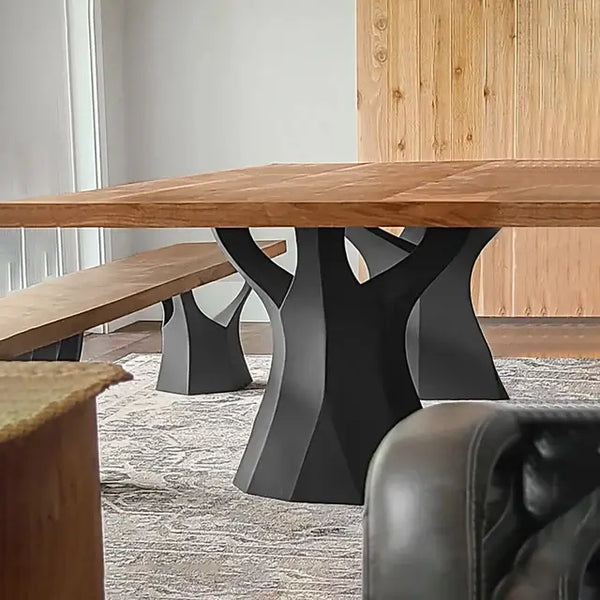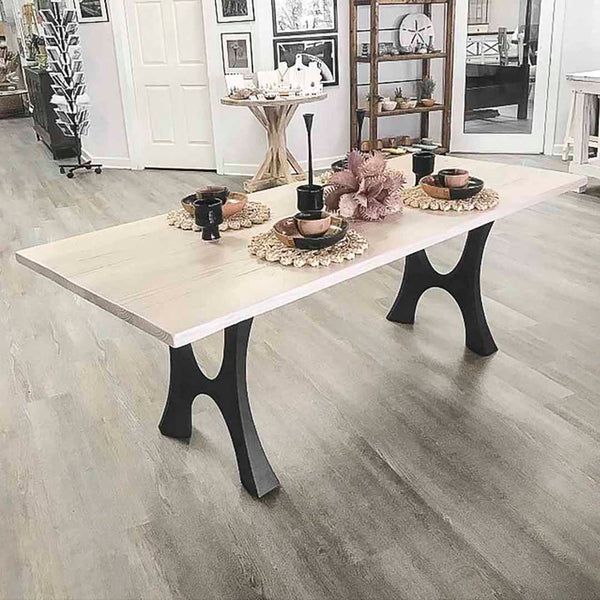How to Pick the Perfect Dining Space Table Legs for Your Home Design
Choosing the optimal dining room table legs is a nuanced process that calls for careful consideration of various components, including your room restrictions, aesthetic preferences, and functional requirements. The interplay between measurements, materials, and designs can significantly affect the setting of your eating area, making it essential to approach this decision methodically.
Assess Your Dining Room
Examining your dining area is important for selecting the right table legs that match both looks and performance. Begin by gauging the dimensions of your dining location, including ceiling elevation, floor area, and proximity to other furnishings. This info will certainly help establish the proper size and height of your eating table, which directly influences the selection of table legs.
Next, think about the design and layout of your dining area. An open-concept layout may benefit from table legs that use aesthetic lightness, such as slender metal or acrylic choices. On the other hand, an extra traditional setting might require tough wooden legs that offer a feeling of durability.
Review the existing color palette and materials in your dining area. Balancing the table legs with these aspects produces a natural appearance that boosts the total style. Additionally, think about the functionality needed in your area. As an example, if you often hold big events, think about legs that supply additional support and stability.
Eventually, an extensive analysis of your eating area will direct you in making an educated choice, making sure that your table legs not only boost the visual appeal however likewise serve sensible purposes.
Consider Your Design Preferences
When choosing dining space table legs, it is vital to assess your individual style preferences, as they significantly affect the general aesthetic of your dining space. Your option of table legs can either enhance or contrast with existing decoration, making it crucial to straighten them with your preferred indoor style theme.
If your home leans in the direction of a modern aesthetic, take into consideration smooth metal or minimal wooden legs that give a clean, uncluttered appearance. For a more typical technique, ornate wood legs with intricate carvings can include a touch of sophistication and sophistication. Industrial designs take advantage of robust, raw products such as redeemed timber and steel combinations, mirroring a rugged appeal.
Additionally, farmhouse and rustic styles often prefer sturdy, chunky legs that stimulate a sense of warmth and comfort. Alternatively, if your décor is diverse, you could choose unique forms or a mix of products to create visual passion.
Evaluate Product Options
The selection of product for eating room table legs plays an essential duty in both toughness and visual allure. Common products include wood, metal, and composite choices, each offering distinctive characteristics that can influence the overall look and long life of your table.
Timber is a timeless selection, recognized for its heat and versatility. Woods like oak and walnut give extraordinary stamina and can be completed in different spots to match any type of design. Nevertheless, softwoods like pine are much more prone to dents and scrapes, making them less optimal for high-traffic areas.
Steel legs, frequently crafted from steel or aluminum, exude modernity and commercial appeal. They are extremely resilient and resistant to wear, making them ideal for family members with youngsters or regular gatherings (dining room table legs). In addition, steel can be finished in numerous shades, improving the personalization possibilities
Composite products, such as MDF or laminate, offer affordability and varied designs. While normally much less durable than strong wood or steel, they can still supply a stylish look and are frequently easy to preserve.
Ultimately, the material you choose need to line up with your way of life, aesthetic preferences, and the degree of usage your dining table will certainly experience.
Determine Height and Size
Selecting the ideal height and dimension for your dining-room table is necessary for both capability and comfort. The basic elevation for dining tables generally varies from 28 to 30 inches, enabling enough legroom for a lot of people when seated. It is important to take into consideration the dimensions of your dining room and the kinds of chairs you navigate here plan to make use of.

Furthermore, consider the proportions of your dining room. A larger table in a spacious location can develop a grand setting, while a smaller sized table functions well in even more intimate setups. Eventually, the ideal elevation and size will harmonize with your total decor and boost the eating experience for you and your visitors.
Explore Personalization Opportunities

In addition, the style of the legs can be tailored to fit numerous designs, such as rustic, modern, or industrial. For circumstances, tapered legs can evoke a mid-century contemporary feel, while beefy, block-style legs may resonate with traditional Your Domain Name or farmhouse decoration.
Property owners can also discover color coatings, from natural timber stains to repaint, enabling them to match or contrast with the table top and surrounding style.
Furthermore, leg elevation can be gotten used to suit particular seating setups or personal choices, boosting both convenience and functionality.
Finally, unique embellishments, such as makings or decorative braces, can better personalize the table legs, making the eating experience not just a declaration but a meal item in the home. By considering these personalization alternatives, homeowners can create a dining-room table that truly shows their uniqueness.
Verdict
Selecting the optimal dining-room table legs calls for careful consideration of different variables, including the dimensions of the dining area, style choices, product toughness, and desired height. Customization choices additionally boost the capacity to attain a natural visual that enhances the overall decor. By systematically assessing these aspects, house owners can make sure that the selected table legs not just meet practical requirements however also contribute positively to the dining experience and setting of the home.
Picking the ideal eating area table legs is a nuanced process that needs cautious consideration of various elements, including your room restraints, visual preferences, and useful needs.Examining your eating area is important for selecting the right table legs that complement both visual appeals and functionality.When determining dimension, determine the location where the table will certainly be put to ensure it fits comfortably, permitting for at the very least 36 inches of clearance around the table for easy movement. A bigger table in a roomy area can produce a grand atmosphere, while a smaller table functions well in more intimate setups.Choosing the optimal dining area table legs needs cautious consideration of various variables, including the measurements of the dining room, style preferences, material sturdiness, and desired elevation.